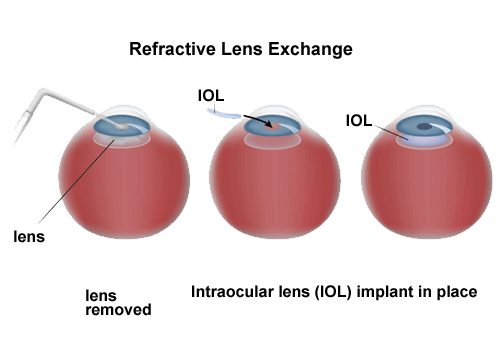Refractive Lens Exchange
Refractive Lens Exchange is a life-changing procedure that can help you reduce your dependence on glasses or contact lenses. At Tylock-George Eye Care, our skilled eye doctors use the latest technology and advanced intraocular lenses to provide customized vision correction solutions tailored to your unique needs and lifestyle.

What is Refractive Lens Exchange?
Refractive Lens Exchange, also known as RLE, is a surgical procedure that corrects vision problems by replacing the eye’s natural lens with an artificial intraocular lens, also called an IOL. This procedure is similar to cataract surgery.
However, instead of restoring vision affected by cataracts, the RLE the procedure is done to improve visual freedom and reduce your dependency on visual aids. RLE can be a great option for those who have refractive errors like nearsightedness, farsightedness, or astigmatism.

RLE can also help correct presbyopia, which is the age-related loss of near vision that makes it difficult to read or perform close-up tasks without reading glasses. RLE can significantly reduce the need for glasses or contact lenses, providing you with improved vision and a better quality of life.
Who is a Good Candidate for Refractive Lens Exchange?
Good candidates for Refractive Lens Exchange are typically over forty years old. It’s important that you have healthy eyes without any significant eye conditions, such as glaucoma, diabetic retinopathy, or macular degeneration.
The best way to know whether or not you might be a good candidate for RLE is to visit your eye doctor at Tylock-George Eye Care for a full evaluation. At this appointment, you can talk to your eye doctor about your vision goals, and they can help guide you to the best option for your needs and eyes.
What Happens During Refractive Lens Exchange?
Refractive Lens Exchange is an outpatient procedure that typically takes less than thirty minutes per eye. The steps involved in the procedure are:
1. Numbing Eye Drops
First, your eye doctor will apply numbing eye drops to ensure you are comfortable during the procedure.
2. Incision
Next, your eye surgeon will create a small incision in the cornea, the clear front part of the eye, in order to access your natural lens.
3. Lens Removal
Then, your eye surgeon will gently break up the natural lens into small pieces and remove them from your eye.
4. IOL Implantation
The selected IOL is carefully inserted through the incision and positioned in the lens capsule, where it will remain permanently.
5. Closure
The incision in your cornea is self-sealing and typically does not require stitches.
After the procedure, you will need to use prescribed eye drops to prevent infection and promote healing.

What IOLs Are Available for RLE?
When considering Refractive Lens Exchange at Tylock-George Eye Care, you have access to a wide range of advanced intraocular lens (IOL) options. We are excited to begin offering the revolutionary Tecnis Odyssey lens.
This innovative IOL offers clear vision for distance, intermediate, and near ranges. The Odyssey IOL offers exceptional contrast preservation, enhancing the quality of your vision.
This lens offers an excellent range of vision, making it an excellent choice for those seeking to reduce their dependence on corrective eyewear after RLE. In addition to the Odyssey lens, we provide a comprehensive selection of premium IOLs to meet your unique visual needs, including:
- PanOptix
- Vivity
- RayOne EMV
- Monofocal Toric
- Monofocal
Our experienced eye care professionals will work closely with you to determine the most suitable IOL based on your lifestyle, visual requirements, and overall eye health, ensuring optimal results from your RLE procedure.
Do you want to learn more about RLE or determine if you might be a good candidate for the procedure? Request Appointment at Tylock-George Eye Care in Dallas, TX, today!


